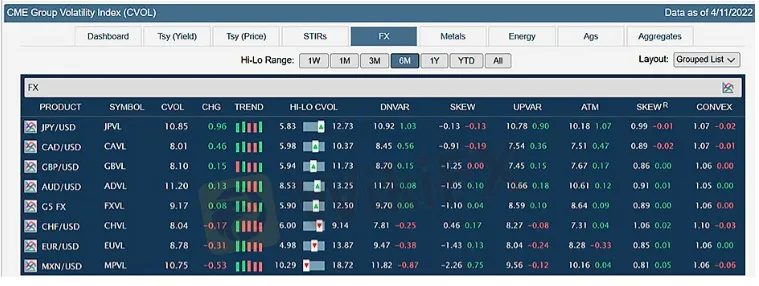简体中文
繁體中文
English
Pусский
日本語
ภาษาไทย
Tiếng Việt
Bahasa Indonesia
Español
हिन्दी
Filippiiniläinen
Français
Deutsch
Português
Türkçe
한국어
العربية
Excell with Options: Leveraging exposure to JPY and MXN with FX options
Abstract:As volatility levels fluctuate in the FX markets, Rich reviews two strategies in different currencies
JPY/USD ratio spread for volatility to remain elevated
MXN/USD call vs. put spread for volatility to pick up from a low base
2022 has been a year for macro moves. COVID-19 problems continue. There is a land war in Europe. There are fears of economic slowdown in Europe and the U.S. caused by inflation, which has brought aggressive central bank policy into play. There is a seemingly endless supply of negative or potentially negative headlines. This brings me back to my early days in the market when I started on the CME Group floor trading FX options. I know these markets get the most interesting when there are major macro stories in the world.
The first stop for me was to go to CME Groups Volatility Index (CVOL) to view how the level of volatility looks relative to the last six months or so. With all these headlines, is a good amount of future volatility being priced in already? From Figure 1, we can gather that G5 FX – the major currency pairs – all are seeing volatility levels that are elevated versus the last six months of history, particularly JPY/USD. On the flipside, MXN/USD is at the low end of its range.
Figure 1: CME Group FX CVOL

Thus, I wanted to look into JPY and MXN, as the levels of volatility relative to their range suggest there could be an opportunity. What if there was a product for which the short-term chart was suggesting much higher levels, but was close to the downtrend of a 30-year channel? You might think I was referring to 10-Year U.S. Treasury Yields. In fact, I am referring to USD/JPY. Figure 2 shows USD/JPY for the last 35 years. I find it interesting because when I first went to Japan for a study abroad program in 1986, I remember thinking how inexpensive everything was. I went back again in 1989 and 1991. Each time, goods were seemingly more expensive. The included chart shows this entire period with some other interesting annotations. The low was at 79.75 in 1995, which I point out because I was short gamma in USD/JPY at that time and actually sold that low price. Nothing like selling the low. I was very happy then in 2011, when a new low was set. I no longer had the record for the worst USD/JPY spot trade in history. You can see in 2012-2014, the USD got quite a bit stronger versus the Yen. This trend coincides with the election of Prime Minister Abe and the introduction of his Three Arrows plan. According to Wikipedia: Abenomics is based upon “three arrows” of monetary easing from the Bank of Japan, fiscal stimulus through government spending, and structural reforms. After that initial weakening, the yen went sideways for the last seven years, and this downtrend line remained intact. That is, until recently. While major central banks around the world are in various stages of tightening monetary policy to combat inflation, the Bank of Japan recently re-confirmed its zero-rate policy. Presumably, this is an attempt to import the inflation from the rest of the world into the Japanese economy, which has been fighting deflation for decades. This news caused the U.S. dollar to strengthen vs. the yen and finally move above this long-term trend line.
Disclaimer:
The views in this article only represent the author's personal views, and do not constitute investment advice on this platform. This platform does not guarantee the accuracy, completeness and timeliness of the information in the article, and will not be liable for any loss caused by the use of or reliance on the information in the article.
Read more

Twin Scam Alert: Broker Capitals is a New Domain of Finex Stock
This week, the Italy financial regulator CONSOB issued a warning against an unlicensed broker named Broker Capitals. When we clicked on Broker Capitals' website, its logo, trade name, and design seemed familiar to us.

Berkshire CEO-designate Abel sells stake in energy company he led for $870 million
Berkshire Hathaway Inc said on Saturday that Vice Chairman Greg Abel, who is next in line to succeed billionaire Warren Buffett as chief executive, sold his 1% stake in the company’s Berkshire Hathaway Energy unit for $870 million.

Paying particular heed to payrolls
A look at the day ahead in markets from Alun John

Dollar extends gains against yen as big Fed hike bets ramp up
The dollar extended it best rally against the yen since mid-June on Monday, buoyed by higher Treasury yields after blockbuster U.S. jobs data lifted expectations for more aggressive Federal Reserve policy tightening.
WikiFX Broker
Latest News
Why Are Financial Firms Adopting Stablecoins to Enhance Services and Stability?
Experienced Forex Traders Usually Do This Before Making a Lot of Money
Octa vs XM:Face-Off: A Detailed Comparison
When High Returns Go Wrong: How a Finance Manager Lost RM364,000
Bridging Trust, Exploring Best—WikiEXPO Hong Kong 2025 Wraps Up Spectacularly
Interactive Brokers Expands Crypto Trading with Solana, XRP, Cardano, and Dogecoin
Fidelity Investments Explores Stablecoin Innovation in Digital Assets Sector
Why More People Are Trading Online Today?
SEC Ends Crypto.com Probe, No Action Taken by Regulator
Broker Comparison: FXTM vs XM
Currency Calculator







